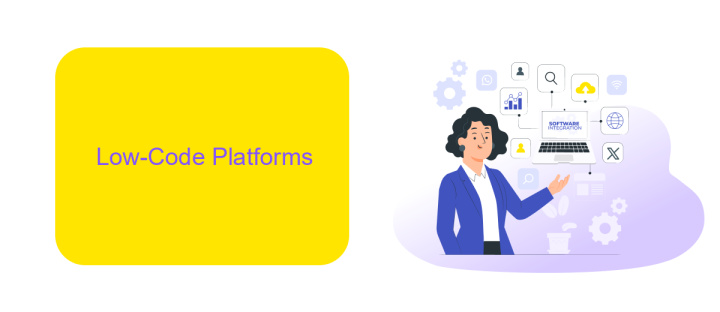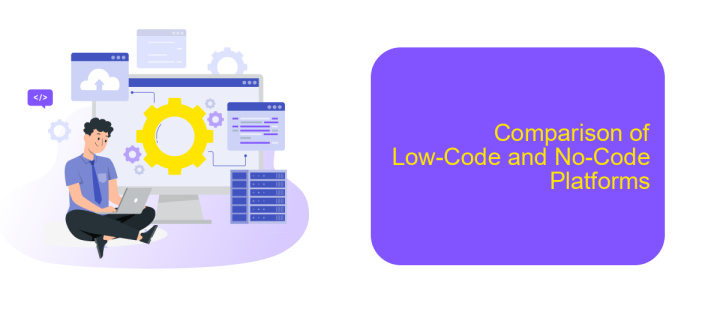Low-Code No-Code Platforms Comparison
In today's fast-paced digital landscape, Low-Code and No-Code platforms have emerged as game-changers, enabling businesses to develop applications rapidly with minimal coding expertise. This article provides a comprehensive comparison of these platforms, highlighting their key features, advantages, and limitations to help you make an informed decision on which solution best fits your organization's needs.
Introduction
In recent years, the landscape of software development has been significantly transformed by the emergence of Low-Code and No-Code platforms. These innovative solutions empower individuals with little to no coding experience to create applications, automate workflows, and integrate services seamlessly. By democratizing software development, these platforms are enabling businesses to accelerate their digital transformation efforts and reduce dependency on traditional IT resources.
- Rapid application development
- Cost efficiency
- Enhanced collaboration between IT and business teams
- Scalability and flexibility
One of the key benefits of Low-Code and No-Code platforms is their ability to integrate various services effortlessly. For instance, ApiX-Drive offers a robust solution for setting up integrations without the need for complex coding. This platform allows users to connect different applications and automate data flows, thereby enhancing productivity and operational efficiency. As businesses continue to seek agile and cost-effective solutions, the adoption of Low-Code and No-Code platforms is expected to rise, further driving innovation and growth.
Low-Code Platforms

Low-code platforms are designed to simplify the application development process by providing a visual interface and pre-built components, reducing the need for extensive coding knowledge. These platforms enable businesses to rapidly develop, deploy, and manage applications, fostering greater agility and innovation. They are particularly beneficial for organizations looking to accelerate digital transformation and reduce dependency on traditional IT development cycles.
One of the key advantages of low-code platforms is their ability to integrate seamlessly with various third-party services and APIs. For instance, ApiX-Drive is a service that facilitates the integration of different applications and systems, allowing users to automate workflows without extensive coding. This capability enhances the functionality of low-code platforms, enabling users to create more complex and interconnected applications with minimal effort. By leveraging services like ApiX-Drive, businesses can streamline operations and improve efficiency, making low-code platforms an invaluable tool in the modern digital landscape.
No-Code Platforms

No-code platforms are revolutionizing the way businesses develop applications by enabling users without any coding skills to create functional and complex apps. These platforms provide a user-friendly interface, typically with drag-and-drop features, that allows for the rapid development and deployment of applications.
- Ease of Use: No-code platforms are designed for non-technical users, making it simple to create apps without any programming knowledge.
- Cost-Effective: These platforms reduce the need for hiring specialized developers, thereby lowering the overall development cost.
- Speed: With pre-built templates and components, applications can be developed and launched much faster compared to traditional coding methods.
- Flexibility: Users can easily make changes and updates to their applications without needing to go through a complex development process.
One of the significant advantages of no-code platforms is their ability to integrate with other services seamlessly. For instance, ApiX-Drive allows users to connect various applications and automate workflows without any coding. This integration capability ensures that businesses can streamline their processes and improve efficiency, making no-code platforms a valuable tool for modern enterprises.
Comparison of Low-Code and No-Code Platforms

Low-code and no-code platforms have revolutionized the way businesses develop applications by significantly reducing the need for extensive coding knowledge. Low-code platforms provide a more flexible environment where users can write some code to customize applications, whereas no-code platforms are designed for users with little to no coding experience, relying heavily on visual interfaces and pre-built templates.
Both types of platforms aim to accelerate the development process, but they cater to different user bases and use cases. Low-code platforms are often preferred by developers and IT professionals who need to create complex, scalable applications. On the other hand, no-code platforms are ideal for business users and non-developers who need to quickly build and deploy simple apps without technical assistance.
- Low-code: Requires some coding knowledge, more flexible, suitable for complex applications
- No-code: No coding required, user-friendly, ideal for simple applications
- Integration: Both can integrate with other services; for example, ApiX-Drive facilitates seamless integration between various apps and systems
In summary, the choice between low-code and no-code platforms depends on the specific needs of the project and the technical expertise of the users. Low-code platforms offer more customization and scalability, while no-code platforms provide a quicker, more accessible solution for non-technical users. Both platforms, however, play a crucial role in democratizing application development and enabling faster innovation.
Conclusion
In conclusion, the landscape of Low-Code and No-Code platforms offers a diverse range of tools that cater to different business needs and technical proficiencies. These platforms empower organizations to accelerate development processes, reduce costs, and enable non-technical users to contribute to application creation. Selecting the right platform depends on various factors, including the complexity of the applications, integration capabilities, and scalability requirements.
Moreover, integrating these platforms with existing systems can be streamlined using services like ApiX-Drive, which simplifies the process of connecting various applications and automating workflows. By leveraging such integration services, businesses can ensure seamless data flow and enhance operational efficiency. Ultimately, the choice of a Low-Code or No-Code platform should align with the organization's strategic goals and technical landscape, ensuring that it supports both current and future needs.
FAQ
What are Low-Code and No-Code platforms?
Who can benefit from using Low-Code and No-Code platforms?
How do Low-Code and No-Code platforms handle integrations with other systems?
Are Low-Code and No-Code platforms secure?
Can Low-Code and No-Code platforms scale with my business needs?
Time is the most valuable resource in today's business realities. By eliminating the routine from work processes, you will get more opportunities to implement the most daring plans and ideas. Choose – you can continue to waste time, money and nerves on inefficient solutions, or you can use ApiX-Drive, automating work processes and achieving results with minimal investment of money, effort and human resources.

